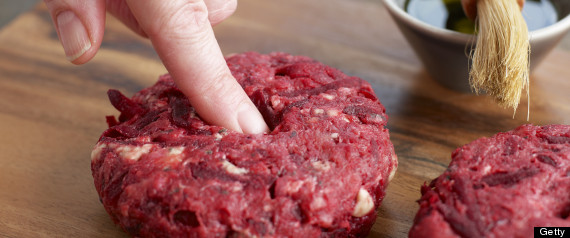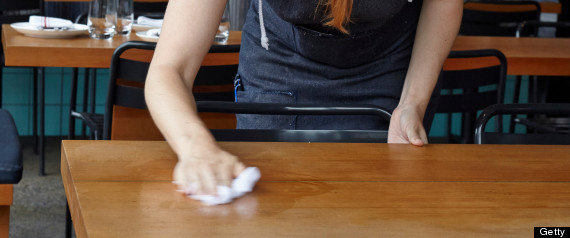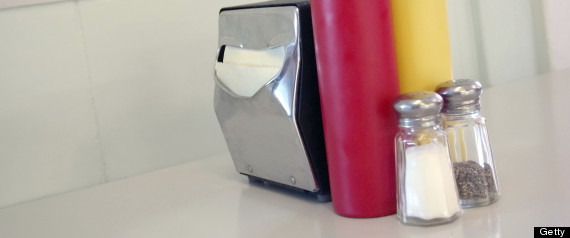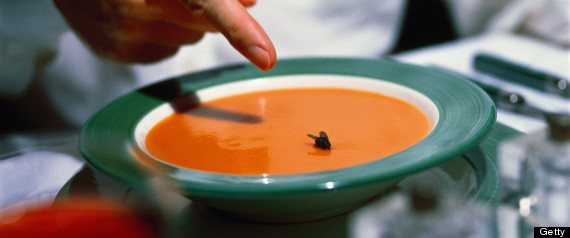For peace of mind, we may prefer to imagine restaurants as sanitized bastions of total cleanliness. Their spotless surfaces have to exemplify the lofty standards upheld by tax-funded health and safety organizations, with everything from tables to spatulas properly scrubbed after each use. That's true, right? Guys?
But of course, restaurants vary in terms of actual sanitation practices. We recently revealed the hard, germ-coated truth about lemon wedges -- one study found 70 percent of them to contain microbial growth. Not all such growth is harmful to human health. Even one of the researchers behind the lemon study concedes, "Microbes are ubiquitous ... You're not going to escape unscathed forever." You can sure try, though.
Here are some other things to keep in mind the next time you're dining out.

In a 2013 survey of 491 food service workers from 391 restaurants throughout nine states, the Center for Disease Control found that 60 percent remembered going into work at least once while sick. Of those, 20 percent went into work despite having symptoms like vomiting or diarrhea. Not okay!
Only seven percent reported being forced by management to work while feeling under the weather. So why'd they do it? The most common reasons cited were lack of paid sick leave, inability to find someone to take their shift, obligations to co-workers and thinking their symptoms weren't that contagious. Meanwhile, the CDC reports that handling of food by an infected person is a big factor in at least two-thirds of pathogenic outbreaks -- so someone is wrong here.
Saru Jayaraman of Restaurant Opportunities Centers United suggests giving the almost 90 percent of restaurant workers who reported inability to take paid sick leave access to that privilege would cut down on the scourge of flu each year. Activists in the District of Columbia recently won a victory for restaurant workers, helping pass a bill giving them the right to use paid sick leave after 90 days on the job.

In a study of 321 workers preparing food in restaurants, the CDC found they engaged in activities that required hand washing -- such as "preparing raw animal product" or "touching body" -- an average of 8.6 times per hour.
In reality, they're washing their hands about 2-3 times per hour. The study showed an increased likelihood to wash hands when the workers were actually preparing food, suggesting people generally understand the link between sterilization and not subjecting a dining room full of people to the horrors of food poisoning. So that's a plus. Hand-washing habits, however, tended to become less frequent as the restaurant became more crowded, due, as you might imagine, to the pressure of feeding so many at once.

Back in 2006, a Florida seventh-grader made national news with a science project showing how ice at various fast food restaurants in her hometown contained more bacteria than the toilet water in those same establishments. Gross, right? It seems that some places may not be giving the ice machines enough TLC, or else the hands that scoop it into glasses are adding contaminants of their own.
Aside from sounding disgusting, bacteria in ice isn't necessarily bad for human health unless it's the wrong kind of bacteria. In 2008, a local Indianapolis news channel performed a similar experiment in 25 area bars. The ice in 13 of those tested positive for coliform bacteria, certain types (read: E. coli) of which can make people sick. Last June, The Daily Mail reported that ice in six out of ten fast food restaurants sampled on London's High Street contained elevated levels of normally occurring bacteria -- suggesting a failure to properly clean the machines.

A disturbing 2013 report by the CDC stated that 40 percent of the 448 restaurant managers surveyed "never, rarely, or only sometimes" used separate cutting boards for raw meat, including chicken. At some point, it seems, someone might have chopped your veggies over raw chicken residue. Yum!
Chicken, however, isn't to be messed around with. According to the CDC, poultry is the fourth most common item associated with food poisoning, and the biggest culprit in deaths by food-borne illness. So it's a bit concerning that only 43 percent of managers correctly identified the temperature at which chicken needed to be cooked to safely eat as recommended by the FDA -- 165 degrees.

Of 385 restaurants included in a 2013 CDC survey, 77 percent of kitchen managers said they "sometimes, rarely, or never" use a thermometer to confirm a hamburger is ready to eat. Most cooks use subjective measures such as interior pinkness or exterior juiciness. Which might be a good enough measure for your own backyard barbecue, but eating in a restaurant already sets you at a higher risk for an E. coli infection.
Of the burgers cooked medium-rare, 40 percent were less than 155 degrees -- "undercooked" as per FDA guidelines aimed to kill off E. coli.

Or so said Dr. Chuck Gerba of the University of Arizona on Good Morning America. Gerba and three other researchers took samples from 12 restaurants in three states, finding an average of 185,000 bacteria on the menu. Most were not harmful varieties.
However, one team of researchers published a 2013 report suggesting menus can serve as vehicles for pathogens such as salmonella and E. coli. The bacteria preferred hanging out on laminated menus, whose tiny crevices formed welcoming spots to chill. In 2012, ABC News Consumer Correspondent Elisabeth Leamy tested samples from ten restaurants in three states with the help of the New York University Microbiology Department. Menus were second only to seats in terms of germs -- microbiologists even identified bacteria that cause strep throat and staph infections on two of them.

Part of the issue with menus is that busy restaurants often don't have time or manpower to sanitize each one before the next table needs to see it. But it appears that even cloths used to wipe down laminated menus might not be the best tools for the job. In one 2006 study of 23 restaurant dishcloths from 10 establishments, researchers found coliform bacteria on 89.2 percent of the cloths -- E. coli specifically on 54 percent. Tabletops cleaned with such rags were covered with 45 times more bacteria AFTER cleaning than prior to it.
A 2010 study by the UK's Health Protection Agency sampled 133 cloths from 120 restaurants. The researchers reported unsafe levels of bacteria on 56 percent of them -- including E. coli, Staphylococcus and listeria -- which they explained could be spread onto surfaces and transferred to utensils.

Half the shakers in ABC News' investigation were contaminated with bacteria. In a 2010 investigation by Good Morning America, ketchup and mustard bottles and salt shakers weren't horribly contaminated. The pepper, however, was second just to menus in the show's study of 12 restaurants in three states -- they shakers contained an average of 11,600 microbial organisms.
Bacteria seem to like their spices, though. In 20,000 samples of imported spices tested between 2004 and 2009, the FDA found seven percent contaminated with salmonella. Most likely to be contaminated were pepper, cumin, curry powder, coriander, basil, oregano and sesame seeds.

Flies are pretty gross things to begin with -- they feed on fecal matter and the oozing bits of wounds, for example -- and it's no shocker that they're commonly spotted in and around restaurant dumpsters. What is more surprising and disturbing, however, are the results of a 2006 Kansas State University study of 260 flies that suggest they're capable of transferring antibiotic-resistant bacteria to food served in the nearby establishments.
Another study completed by University of Florida researchers found bacteria in houseflies gathered outside local restaurants not previously thought to be among the 200-some varieties associated with houseflies. The newly discovered bacteria specimens are all known to cause illness in humans.

